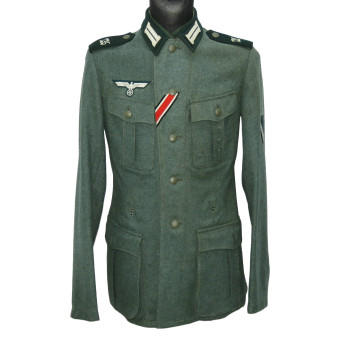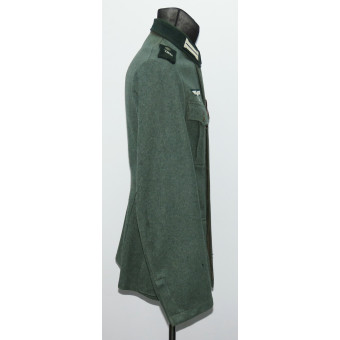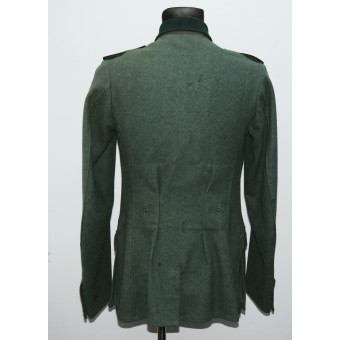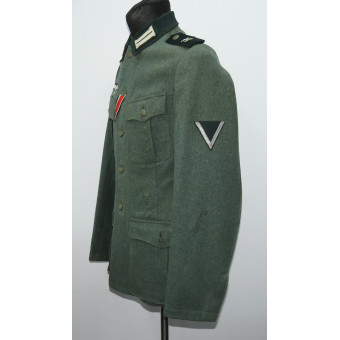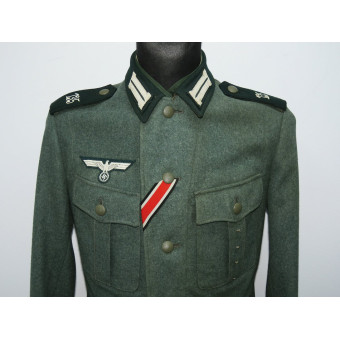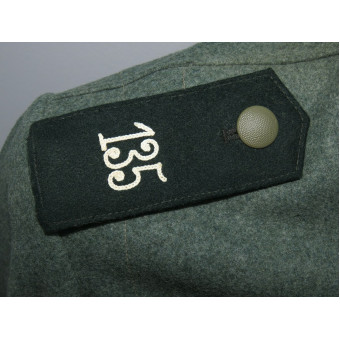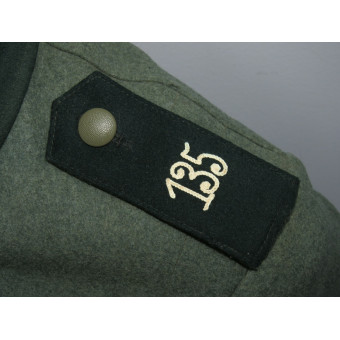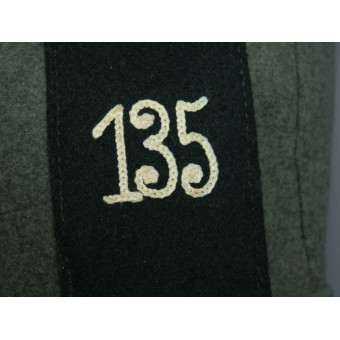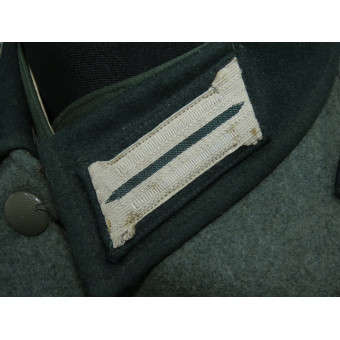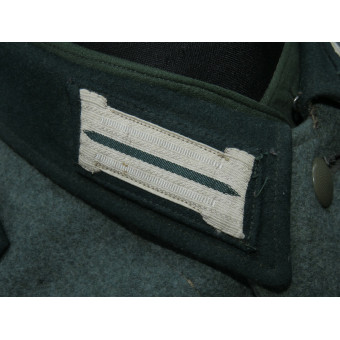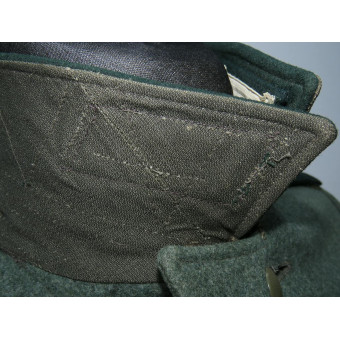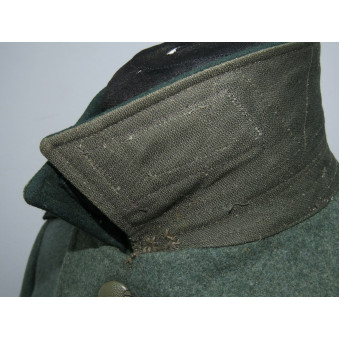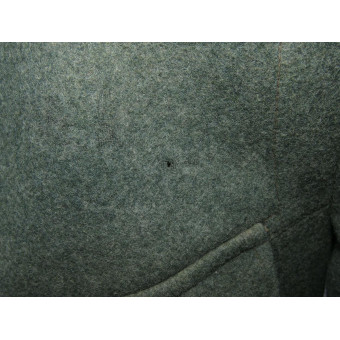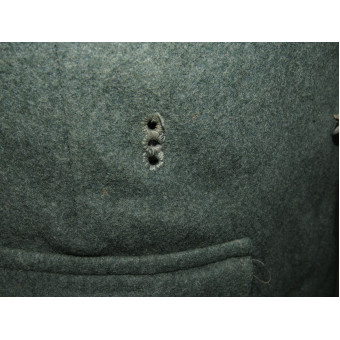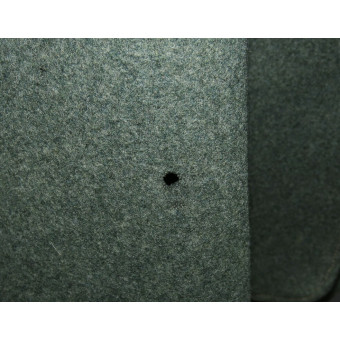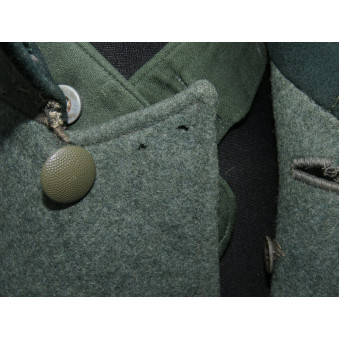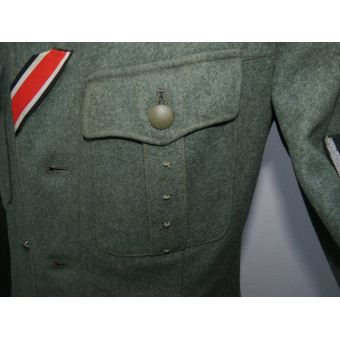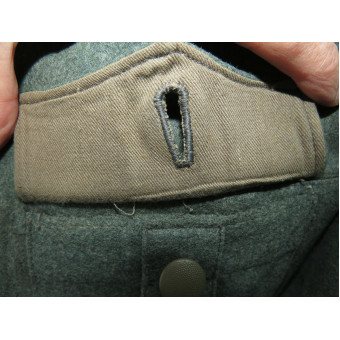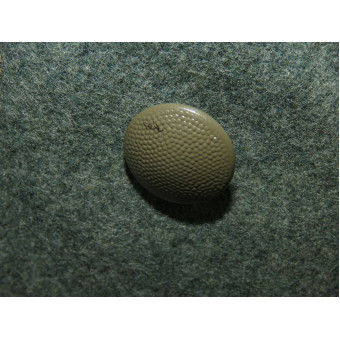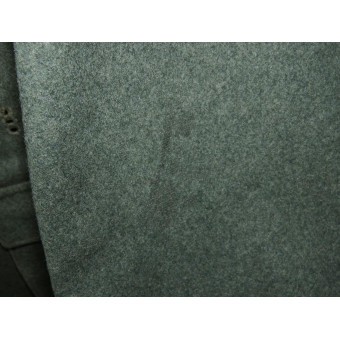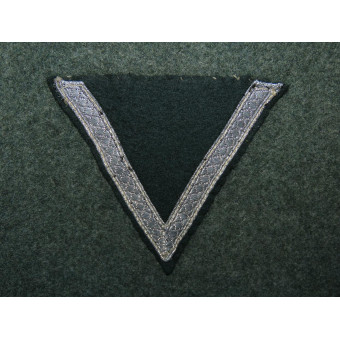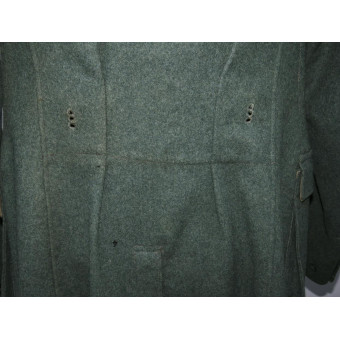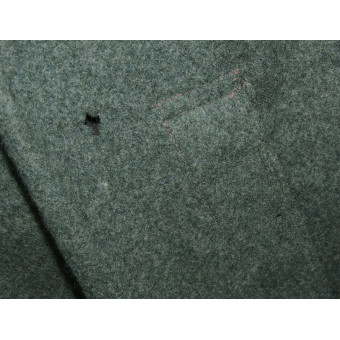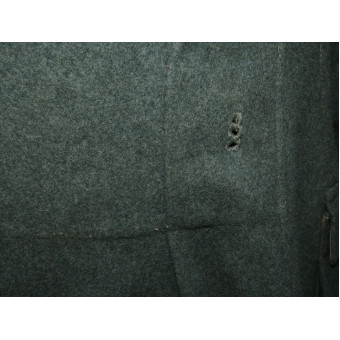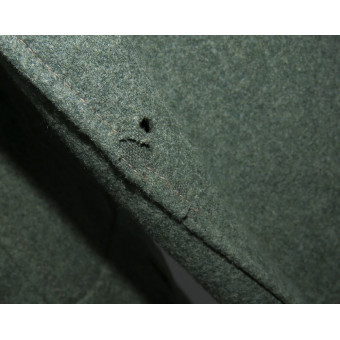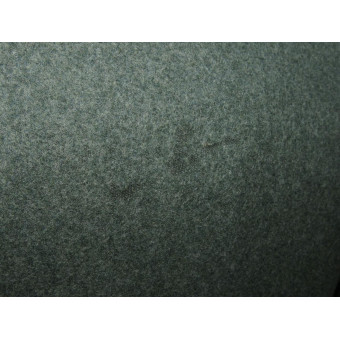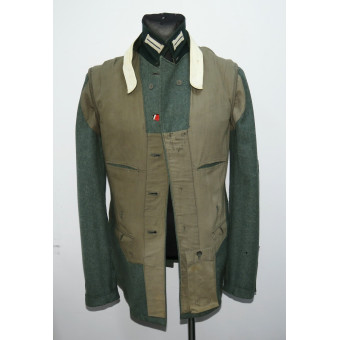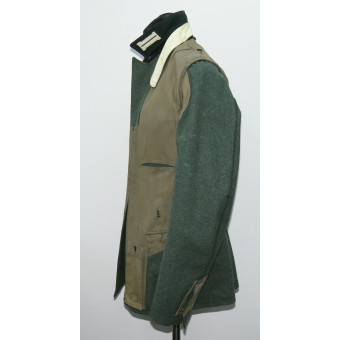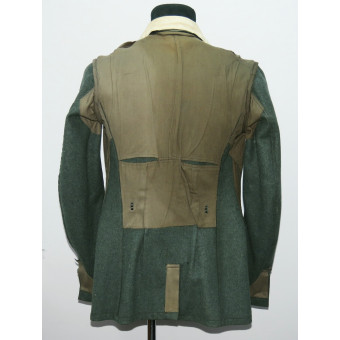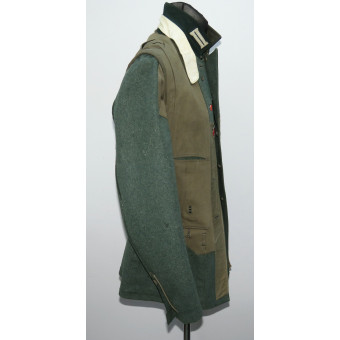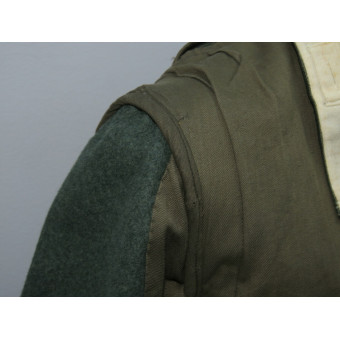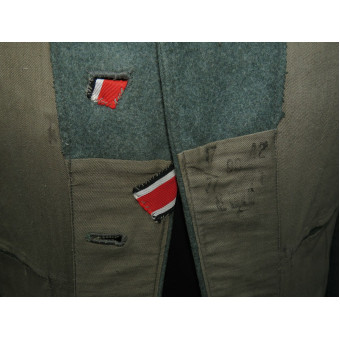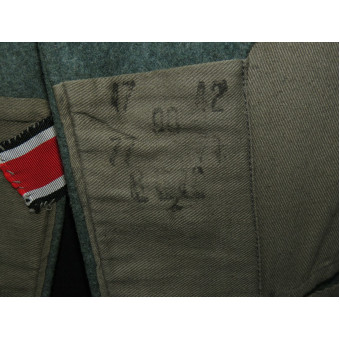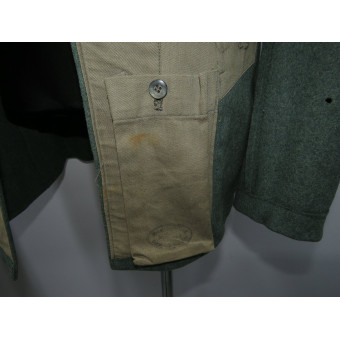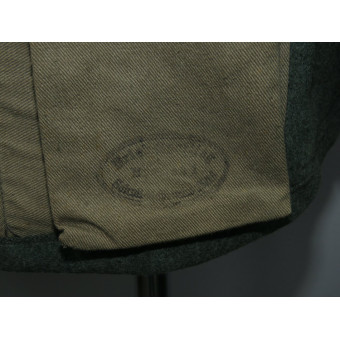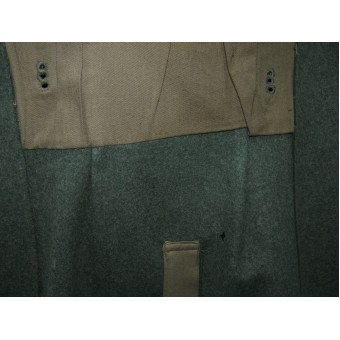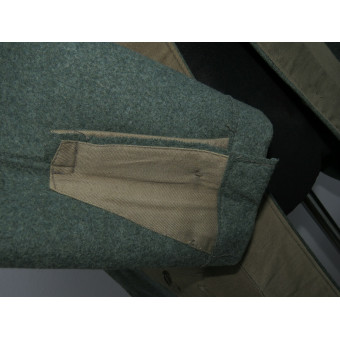1935 Model Wehrmacht Gefreiter’s Tunic of the 135th Infantry Regiment
1935 Model Wehrmacht Gefreiter’s Tunic of the 135th Infantry Regiment
This tunic features early collar tabs with white piping, indicating the infantry branch (Waffenfarbe). The shoulder boards are of the early pentagonal type, embroidered with white field stitch and marked with the number “135,” signifying the regiment.
In the second buttonhole, a ribbon for the Iron Cross is placed. Two loops for awards are sewn on the left breast pocket.
The tunic is in excellent condition, with almost no signs of wear. There are light traces of moth activity on the back, causing minor damage to the nap. A couple of small holes, no larger than a match head, are present.
Tunic measurements:
-
Length from neck to waist: 47 cm
-
Chest circumference: 90 cm
-
Total length: 77 cm
-
Sleeve length: 71 cm
-
Suitable for a height of approximately 185–190 cm
The tunic bears a depot acceptance stamp: B II, 1940. Inside the pocket for the medical bandage, a faint and partially unreadable manufacturer’s stamp is present. All buttons are original and hand-stitched. The collar tabs were also sewn by the owner during the wartime period.
The tunic has survived in excellent condition, with only minor moth traces and slight surface wear.
History and Combat Path of the 135th Infantry Regiment (Infanterie-Regiment 135) of the Wehrmacht
Formation and Structure
The 135th Infantry Regiment was formed on August 1, 1938, after the Anschluss of Austria from units of the 17th Infantry Regiment of the Austrian Bundesheer and became part of the 45th Infantry Division.
-
Headquarters and I Battalion — Ried, Austria
-
II Battalion — Braunau
-
III Battalion — Gmunden
Polish Campaign (1939)
The regiment participated as part of Army Group South, crossing the border near Silesia, breaking Polish defenses on the San River, and engaging in battles for Jarosław and Przemyśl. It remained in occupied Poland for security duties after the campaign.
French Campaign (1940)
The regiment participated in Fall Gelb, crossing the Meuse River, storming Dinant and Charleroi, and taking part in the encirclement of Allied forces in the Belgian pocket and fighting near Dunkirk.
Eastern Front (1941–1944)
Operation Barbarossa (1941): The regiment attacked Brest Fortress, suffering heavy losses, particularly at the Kobrin Gate.
Battle of Smolensk (1941): Participated in river crossings at the Dnieper and Desna and encircled Soviet forces near Smolensk.
Battle for Moscow (1941): Broke through the Mozhaysk Line, fought near Vyazma and Naro-Fominsk, but was repelled during the Soviet counteroffensive at Volokolamsk.
Rzhev Battles (1942–1943)
The regiment engaged in bloody battles near Rzhev, especially at Polunino and Zubtsov, and retreated westward after the second Rzhev battle.
Battle of Kursk and Retreat (1943)
Participated on the northern face of the Kursk salient near Orel, fought in Operation Kutuzov, and retreated towards the Dnieper under heavy losses.
Operation Bagration and Destruction of the Regiment (1944)
In June 1944, the regiment was surrounded in the Bobruysk pocket and was nearly wiped out.
Reorganizations and Commanders
-
October 15, 1942 — Renamed Grenadier Regiment 135
-
Summer 1943 — II Battalion disbanded
-
Autumn 1943 — I Battalion replaced by a unit from Grenadier Regiment 130
-
Commanders: Heinrich Hainschwang, Wilhelm Mittermaier, Richard Veith, Friedrich-Wilhelm John
Conclusion
The 135th Infantry Regiment fought from Poland and France to Moscow and Kursk, ultimately meeting its end in the Bobruysk pocket in 1944.
1935 Model Wehrmacht Gefreiter’s Tunic of the 135th Infantry Regiment
This tunic features early collar tabs with white piping, indicating the infantry branch (Waffenfarbe). The shoulder boards are of the early pentagonal type, embroidered with white field stitch and marked with the number “135,” signifying the regiment.
In the second buttonhole, a ribbon for the Iron Cross is placed. Two loops for awards are sewn on the left breast pocket.
The tunic is in excellent condition, with almost no signs of wear. There are light traces of moth activity on the back, causing minor damage to the nap. A couple of small holes, no larger than a match head, are present.
Tunic measurements:
-
Length from neck to waist: 47 cm
-
Chest circumference: 90 cm
-
Total length: 77 cm
-
Sleeve length: 71 cm
-
Suitable for a height of approximately 185–190 cm
The tunic bears a depot acceptance stamp: B II, 1940. Inside the pocket for the medical bandage, a faint and partially unreadable manufacturer’s stamp is present. All buttons are original and hand-stitched. The collar tabs were also sewn by the owner during the wartime period.
The tunic has survived in excellent condition, with only minor moth traces and slight surface wear.
History and Combat Path of the 135th Infantry Regiment (Infanterie-Regiment 135) of the Wehrmacht
Formation and Structure
The 135th Infantry Regiment was formed on August 1, 1938, after the Anschluss of Austria from units of the 17th Infantry Regiment of the Austrian Bundesheer and became part of the 45th Infantry Division.
-
Headquarters and I Battalion — Ried, Austria
-
II Battalion — Braunau
-
III Battalion — Gmunden
Polish Campaign (1939)
The regiment participated as part of Army Group South, crossing the border near Silesia, breaking Polish defenses on the San River, and engaging in battles for Jarosław and Przemyśl. It remained in occupied Poland for security duties after the campaign.
French Campaign (1940)
The regiment participated in Fall Gelb, crossing the Meuse River, storming Dinant and Charleroi, and taking part in the encirclement of Allied forces in the Belgian pocket and fighting near Dunkirk.
Eastern Front (1941–1944)
Operation Barbarossa (1941): The regiment attacked Brest Fortress, suffering heavy losses, particularly at the Kobrin Gate.
Battle of Smolensk (1941): Participated in river crossings at the Dnieper and Desna and encircled Soviet forces near Smolensk.
Battle for Moscow (1941): Broke through the Mozhaysk Line, fought near Vyazma and Naro-Fominsk, but was repelled during the Soviet counteroffensive at Volokolamsk.
Rzhev Battles (1942–1943)
The regiment engaged in bloody battles near Rzhev, especially at Polunino and Zubtsov, and retreated westward after the second Rzhev battle.
Battle of Kursk and Retreat (1943)
Participated on the northern face of the Kursk salient near Orel, fought in Operation Kutuzov, and retreated towards the Dnieper under heavy losses.
Operation Bagration and Destruction of the Regiment (1944)
In June 1944, the regiment was surrounded in the Bobruysk pocket and was nearly wiped out.
Reorganizations and Commanders
-
October 15, 1942 — Renamed Grenadier Regiment 135
-
Summer 1943 — II Battalion disbanded
-
Autumn 1943 — I Battalion replaced by a unit from Grenadier Regiment 130
-
Commanders: Heinrich Hainschwang, Wilhelm Mittermaier, Richard Veith, Friedrich-Wilhelm John
Conclusion
The 135th Infantry Regiment fought from Poland and France to Moscow and Kursk, ultimately meeting its end in the Bobruysk pocket in 1944.


